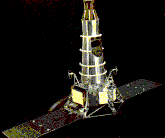
Ranger 7
NSSDC ID: 1964-041A
Description
Ranger 7 was designed to achieve a lunar impact trajectory and to transmit high-resolution photographs of the lunar surface during the final minutes of flight up to impact. The spacecraft carried six television vidicon cameras, 2 wide angle (channel F, cameras A and B) and 4 narrow angle (channel P) to accomplish these objectives. The cameras were arranged in two separate chains, or channels, each self-contained with separate power supplies, timers, and transmitters so as to afford the greatest reliability and probability of obtaining high-quality video pictures. No other experiments were carried on the spacecraft.
Spacecraft and Subsystems
Rangers 6, 7, 8, and 9 were the so-called Block 3 versions of the Ranger spacecraft. The spacecraft consisted of a hexagonal aluminum frame base 1.5 m across on which was mounted the propulsion and power units, topped by a truncated conical tower which held the TV cameras. Two solar panel wings, each 73.9 cm wide by 153.7 cm long, extended from opposite edges of the base with a full span of 4.6 m, and a pointable high gain dish antenna was hinge mounted at one of the corners of the base away from the solar panels. A cylindrical quasiomnidirectional antenna was seated on top of the conical tower. The overall height of the spacecraft was 3.6 m.
Propulsion for the mid-course trajectory correction was provided by a 224-N thrust monopropellant hydrazine engine with 4 jet-vane vector control. Orientation and attitude control about 3 axes was enabled by 12 nitrogen gas jets coupled to a system of 3 gyros, 4 primary Sun sensors, 2 secondary Sun sensors, and an Earth sensor. Power was supplied by 9792 Si solar cells contained in the two solar panels, giving a total array area of 2.3 square meters and producing 200 W. Two 1200 Watt-hr AgZnO batteries rated at 26.5 V with a capacity for 9 hours of operation provided power to each of the separate communication/TV camera chains. Two 1000 Watt-hr AgZnO batteries stored power for spacecraft operations.
Communications were through the quasiomnidirectional low-gain antenna and the parabolic high-gain antenna. Transmitters aboard the spacecraft included a 60 W TV channel F at 959.52 MHz, a 60 W TV channel P at 960.05 MHz, and a 3 W transponder channel 8 at 960.58 MHz. The telecommunications equipment converted the composite video signal from the camera transmitters into an RF signal for subsequent transmission through the spacecraft high-gain antenna. Sufficient video bandwidth was provided to allow for rapid framing sequences of both narrow- and wide-angle television pictures.
Mission Profile
The Atlas 250D and Agena B 6009 boosters performed nominally at launch inserting the Agena and Ranger into a 192 km altitude Earth parking orbit. Half an hour after launch the second burn of the Agena engine injected the spacecraft into a lunar intercept trajectory. After separation from the Agena, the solar panels were deployed, attitude control activated, and spacecraft transmissions switched from the omniantenna to the high-gain antenna. The next day, 29 July, the planned mid-course maneuver was initiated at 10:27 UT, involving a short rocket burn. The only anomaly during flight was a brief loss of two-way lock on the spacecraft by the DSIF tracking station at Cape Kennedy following launch.
Ranger 7 reached the Moon on 31 July. The F-channel began its one minute warm up 18 minutes before impact. The first image was taken at 13:08:45 UT at an altitude of 2110 km. Transmission of 4,308 photographs of excellent quality occurred over the final 17 minutes of flight. The final image taken before impact has a resolution of 0.5 meters. The spacecraft encountered the lunar surface in direct motion along a hyperbolic trajectory, with an incoming asymptotic direction at an angle of -5.57 degrees from the lunar equator. The orbit plane was inclined 26.84 degrees to the lunar equator. After 68.6 hours of flight, Ranger 7 impacted in an area between Mare Nubium and Oceanus Procellarum (subsequently named Mare Cognitum) at 10.70 S latitude, 339.33 E longitude. (selenocentric - Apollo 16 Preliminary Science Report, 29-40, 1972.) Impact occurred at 13:25:48.82 UT at a velocity of 2.62 km/s. The spacecraft performance was excellent.
Total research, development, launch, and support costs for the Ranger series of spacecraft (Rangers 1 through 9) was approximately $170 million.
Alternate Names
- 00842
Facts in Brief
Launch Date: 1964-07-28
Launch Vehicle: Atlas-Agena B
Launch Site: Cape Canaveral, United States
Mass: 365.7 kg
Nominal Power: 200.0 W
Funding Agency
- NASA-Office of Space Science Applications (United States)
Discipline
- Planetary Science
Additional Information
- Launch/Orbital information for Ranger 7
- PDMP information for Ranger 7
- Telecommunications information for Ranger 7
Data collections from Ranger 7
Questions or comments about this spacecraft can be directed to: Dr. David R. Williams.
Selected References
Kosofsky, L. J., Ranger 7, part 1 - Mission description and performance, JPL, Calif. Inst. Technol., TR 32-700, Pasadena, CA, Dec. 1964.
Ranger 7 photographs of the moon, NASA, SP-61, SP-62, and SP-63, Wash., D.C., Sept. 1964 Aug. 1965.
Ranger 6 and 7, TRW, Space Log, TRW Space Technol., Lab., 4, No. 2 17-24, Redondo Beach, Calif., 1964.
Mission operation reports (1963 - 1964), NASA, Off. of Programming, Off. of Prog. Rept., Wash., D.C., 1963-1964.
Ranger Home Page
Ranger 8 Mission
Ranger 9 Mission

